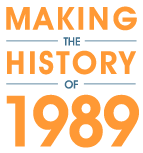Solidarity Comes to Power
Primary Sources
Scenes from Andrzej Wajda’s film, Man of Iron (1981)
Description
Filmed just after Solidarity’s initial spectacular rise in 1980, Andrzej Wajda’s Man of Iron was won immediate global acclaim. Whereas Wajda’s earlier award-winning film, Man of Marble, had focused on the lonely struggle of an idealistic young film student to uncover the truth about the disillusionments and betrayals of the early communist era in Poland, the individual characters in Man of Iron were largely dwarfed by the large-scale contemporary struggle between Solidarity and the regime that served as the film’s backdrop. Indeed, many of the scenes featuring Wajda’s fictional characters were inter-spliced with documentary footage of demonstrations, speeches by Solidarity leaders, and interviews with ordinary Poles. The excerpted scenes are primarily drawn from this documentary footage. They provide some sense of the mix of grievances and ideals that played a role in generating support for Solidarity, as well as the challenges involved in translating this “raw material” of dissatisfaction into a coherent oppositional program. Although Solidarity proved successful in pulling together such an agenda in 1980, the imposition of martial law in December 1981 forced the movement underground and compelled activists to re-think goals and tactics once again.
[ed. note.: The excerpts below refer to the timestamps from the original film.]To see the associated Teaching Module on Solidarity Comes to Power, click here.
Source
Man of Iron, VHS, directed by Andrzej Wajda (1981, Santa, CA: MGM/UA Home Video, 1994).
Primary Source— Full Text
Scene 1: Start at 25:52 Finish at 29:10 This excerpt features striking workers and their families at the Lenin Shipyards in Gdansk explaining the motivations for the strike. Many of those interviewed speak of very specific grievances and hardships: e.g., insufficient vacations, inability to buy basic staples. They also, however, refer to more fundamental problems in the distribution of power, like the lack of accountability of managers and union officials to ordinary workers. These sound bites then segue into a portrayal of a memorial ceremony for workers killed in a previous round of strikes in the shipyards in 1970. Where the initial complaints by individual Solidarity supporters were highly concrete, this ceremony’s use of religious ritual and identification with past struggles provide a sense of an overarching long-term “cause.” Scene 2: Start at 1:04:49 Finish at 1:06:42 This excerpt illustrates some of the formal demands that striking workers ended up issuing to the authorities. Some demands are shown handwritten on sheets, others are recounted orally by Maciek Tomczyk, one of the (fictional) heroes of the film. Most refer to matters of principle and/or structural changes—acceptance of independent trade unions, guarantees for freedom of speech—though there are also some references to “bread-and-butter” issues like wages. Here again, as in the previous excerpt, particular demands give way to more generalized scenes of “solidarity,” as a folk song about the struggle is sung in the background.
How to Cite this Source
Andrzej Wajda, "Scenes from Andrzej Wajda’s film, Man of Iron (1981)," Making the History of 1989, Item #550, https://chnm.gmu.edu/1989/items/show/550 (accessed May 28 2021, 3:38 pm).
